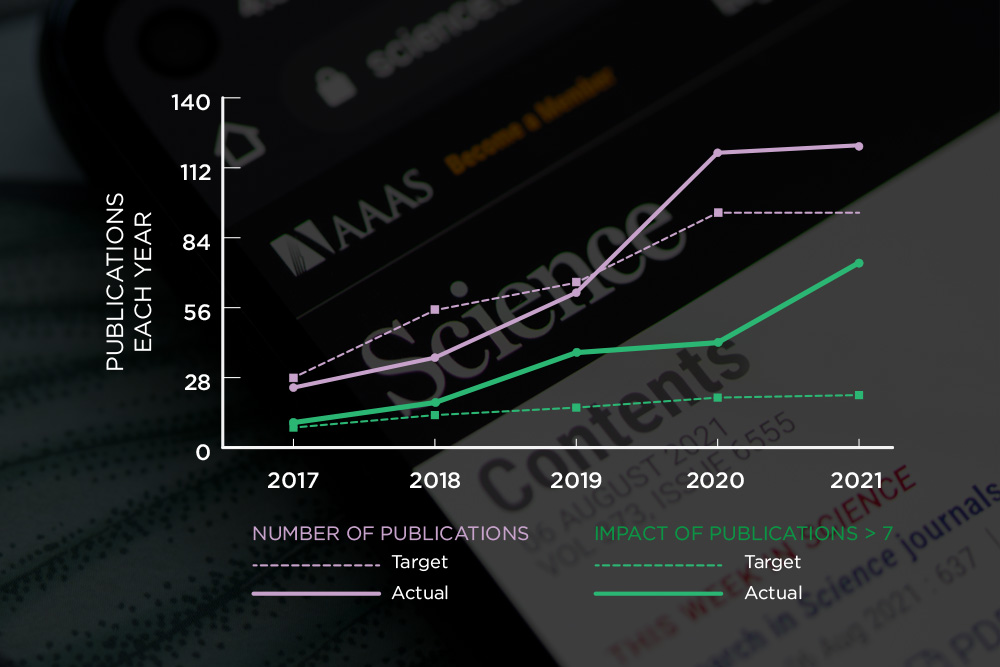Transformational research
FLEET’s transformational research builds on critical mass of Australian strengths
The quality and quantity of FLEET’s research outputs is 'on target': the impact of FLEET’s 381 peer-reviewed papers from 2017 to 2021 (versus a KPI of 370) is reflected in their high impact factors (55% with IF > 7, well above the KPI of 20%) and their citations in other research (almost 7000 times). In addition, FLEET research has led to seven patent applications and one spin-off company.
Recognition of the quality of FLEET researchers’ work is indicated by them having received 16 competitive Australian Research Council (ARC) fellowships (Laureate, Future, DECRA) and six other externally-funded fellowships from 2017 to 2021, exceeding the KPI of eight. FLEET researchers’ 146 invited talks at international conferences from 2017 to 2021 meet our KPI of 148 despite the negative impact caused by the pandemic in the past two years.

Research theme 1: Topological materials FLEET has demonstrated switching a topological insulator via electric fields from topological to conventional insulator, the first such demonstration in any material, and the foundation of a future topological transistor. FLEET’s demonstration of topological switching has attracted interest from the international semiconductor audience that led to the inclusion of topological insulator electronics devices in the IEEE International Roadmap for Devices and Systems.
Research theme 2: Exciton superfluids FLEET is one of few groups worldwide to have demonstrated exciton-polaritons in atomically-thin semiconductors at room temperature, and is a leading contender in global the race to achieve superfluid condensate of exciton-polaritons.
Research theme 3: Light-transformed materials FLEET has established a unique capacity to dynamically manipulate the electronic structure of materials with light, and is the first and only research group to have made a hybrid condensate at cryogenic temperature.
Enabling technology A: Atomically-thin materials FLEET has pioneered new atomically-thin topological materials with large bandgaps necessary for room-temperature operation, and is the only group working in 2D materials with the capacity to make large-area atomically-thin devices.
Enabling technology B: Nanodevice fabrication Potentially transformational research led by FLEET researchers will impact technologies on shorter timescales, including in liquid metals, thermoelectrics, ferroelectrics and hydrogen evolution.
See 2021 progress in each theme and technology in Innovation.

FLEET is linking existing Australian research strengths, and building critical mass with new capacity for interdisciplinary, collaborative approaches.
The growing synergy between research communities at FLEET has seen the percentage of cross-node publications grow from 3.2% (2017) to 16% (2021). Publications involving multiple CIs, AIs, partners and/or nodes make up 61% of all FLEET publications.
The highly interdisciplinary approach within FLEET’s large network of investigators and partners includes collaborations between theoreticians and experimentalists, linked liquid-metals materials growth scientists and characterisation specialists, and between optics scientists and condensed-matter physicists.
Significant new, long-lasting Australia research capacity has been developed, including the new ultra-fast laser system at Monash for optical pump-terahertz probe experiments, the expanded ultra-fast laboratory at Swinburne allowing atomically-thin materials study at cryogenic temperatures, and van der Waals hetero-structure fabrication facilities at Monash, UNSW, and RMIT developed via collaboration with FLEET PI James Hone (Columbia University), the technology’s inventor.